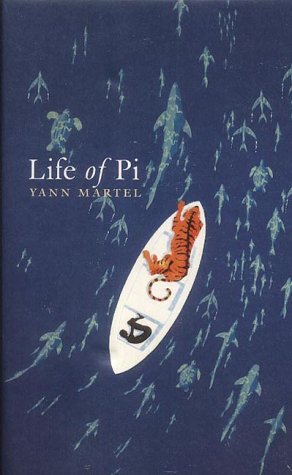The covers of the books nominated for the Booker Prize (British Editions)
22 October 2002

Life of Pi by Yann Martel
The cover features an aerial shot of a tiger at one end of a boat, while a figure in the fetal position is at the other end. The view is from directly overhead, and one sees a school of sharks with a couple of turtles swimming beneath. The colours are muted, and it almost has the feel of a medieval fresco.
This cover would not make me want to pick up the book, let alone read it. The art is somewhat crude. The fetal position silhouette screams some kind of philosophical sentimentality, and the presence of the tiger makes no sense. The fact that these are details that the text takes care of seems beside the point. I wouldn’t want to read a story about a tiger lost at sea, but that’s just me.
Rating: 5/10

Family Matters by Rohinton Mistry
I find this to be a very attractive cover. The title text is in a purple or a blue (scanning usually distorts colours right?) and the author’s name is in red. It is a photograph of someone looking out over the sea; the allusions to Freidrich’s paintings are obvious. The fellow is wearing a gray hat and a matching coat, and is holding an umbrella. We see him from behind. He is also wearing white pants that are short and we can see his bare ankles. The details of his shoes are lost in the darkness at the bottom of the photo. Overall, you have a composition divided into three: the sky/water, the top of the concrete, and its side. The man straddles all three and dominates.
With the hat and the umbrella combo, an anachronism today, the picture is evoking a 20th Century romance and the aesthetics of Beckett, with his tramps in bowler hats. Beckett had said that Freidrich’s paintings helped inspire his work, especially “Waiting for Godot”. This image brings the 19th Century romantic and the 20th Century existentialist together under Mistry’s theme of emigration (Mistry emigrated to Canada from India when he was 20) which seems to embody the existentialist doctrine of determining one’s fate while at the same time alluding to the romance of travel and adventure. Freidrich’s characters confront nature with their independence, while Beckett’s are crushed by nature’s indifference. The 20th Century wrestled with those two concepts in wars that proved man could control nature, but which also showed that nature couldn’t care less about our pettiness. In uniting these two disparate philosophies, this cover is excellent. I’d pick up the book and want to read it.
Rating: 10/10

Unless by Carol Shields
This image at first glance evokes nothing of what the potential contents could be. It is a black & white photograph of mostly tree, but then you notice a girl in the lower right, stooping to pick up (?) or push (?) a ball. She has a bag at her waist, but it looks old as if it could be made of leather. You can also see that her hair is tied in a pony tail, and that she is wearing a white shirt with a skirt. The message conveyed is that she is either on her way or coming from school. Has she found this ball? Is she picking it up to toss it back to an afterschool soccer game?
The tree is an oak, and by it’s size one can see that it is very old. A creature of endless centuries next to one so delicately young. A picture from the 1930’s or something. I wouldn’t be inclined to pick up this book. The image is a sentimental evocation, and the author’s name is bigger than the title. At the bottom one reads that she won the Pulitzer Prize: obviously now the author is a literary Midas and if she wants to bore us with some sentimental memoir cast as fiction, than the publishing industry isn’t going to stop her, because, hey, it might get nominated for the Booker Prize or something.
The fact that the novel isn’t a sentimental memoir set in the 30s is why this cover ultimately fails semiotically. The image is a nice enough photograph and it would look nice in a hallway I guess (the hallway of some dreary bourgeois). In the way it freezes the dynamics of the scene it leaves me uncomfortable, which creates a dynamic nonetheless.
Rating: 7/10

The Story of Lucy Gault by William Trevor
For some reason, amazon.co.uk doesn’t have a “see larger photo” for this title, so I have to work from the unclear image provided on it’s sales page. At first glance it looks like the stone markers of some prehistoric Stonehenge-like ring, though through squinty eyes, one can make out the ripples of sand on a beach. This image then is perhaps the weathered and eroded wooden stumps of on old pier at low tide. Both the initialy percieved image and the one actually present convey age, and the handwritten title, white against the gray-blue sky, also implies a story set in an era before typing was so common.
The sea sure is popular with these cover designers. The use of handwriting points to an historical story. The book begins in the 1920s, so this is effective. But the use of the sea image is so generic, and in the context of the other nominated books, cliché (it’s cliché anyway but worse when next to 3 other books with the same subject matter) but the designer cannot be faulted for that. I’m bored by this cover and wouldn’t pick it up off the shelf.
Rating: 4/10

Fingersmith by Sarah Waters
Is the text set in the 19th Century, or are these the gloves of an archivist? They have buttons, so I doubt it. Perhaps these are servant’s gloves? The title’s font features an elaborate “f” and the rest of the word is a little shaky, like something that came from an oldschool press with a metal typeface.
This cover would entice me to pick up the text, though, I must say at this point, reviews always reflect the bias and predilections of the reviewer, and just because I have a thing for old documents and the dust of archives can’t necessarily translate into your wanting to pick it up too. I’m just sayin’…that because of my interests, this text featuring an image of white gloves on an old table top lying next to a patterned something or other which looks like some book from the 19th Century, would pique my interest.
The online review at amazon.co.uk describes the text as “engrossing lesbian Victoriana”. In communicating the era, this image is effective semiotically, though it still looks a little prissy, and the author’s name is printed too large and with too much kerning.
Rating: 8/10

Dirt Music by Tim Winton
This image conveys a youthfulness that comes across in somehow framing another sentimental sea image (it’s like a rule in book design or something: all novels must have sentimental covers to tug at the heart strings of nostalgia…but then again, I shouldn’t talk, considering the covers of some of my bookworks…). It conveys this youthfulness through the use of the title fonts and the framing. If they’d used a more standard “Times New Roman”-esque serif font, this would have been sentimental. But the use of a sans-serif font speaks to younger folk, and in the way the title is italicized gives it sarcasm. The youth, afterall, are dripping with sarcasm and irony.
Ugh. I thought post 9-11 irony was dead. I was thankful for that, but no, it’s like aspirin, (a cheap and simple miracle drug): there is no better defense against the bewildering stupidity of the status quo than the roll of the eyes. The humor-irony formula is what gets us through the CNN days. That, and turning off the TV to read books with covers of beached boats, seen from the front, with waves gently in the background, the text hovering above the horizon line sans serif, simply conveying author’s name and title.
I’m attracted to the subversion of what could have been another sentimental image. But gawd, another fucking sea cover. I’m in the bookstore browsing and I’m getting seasick. This is absurd…
Rating: 7/10
Winner: You can’t judge a book by it’s cover, but you can judge the cover. This year’s winner of the Booker Prize was Life of Pi but my winner is Family Matters.
Instant Coffee Saturday Edition
- Oct 2002: Appeared in Instant Coffee Saturday Edition Issue No° 10
- 2002-2015 Archived on my websites & blog
- Oct 2015: this version produced